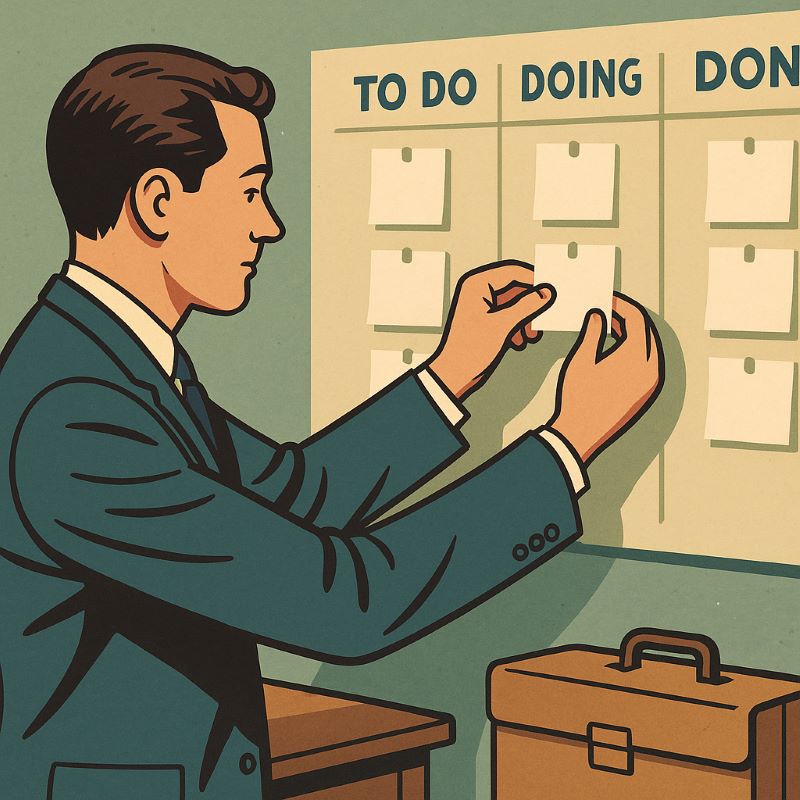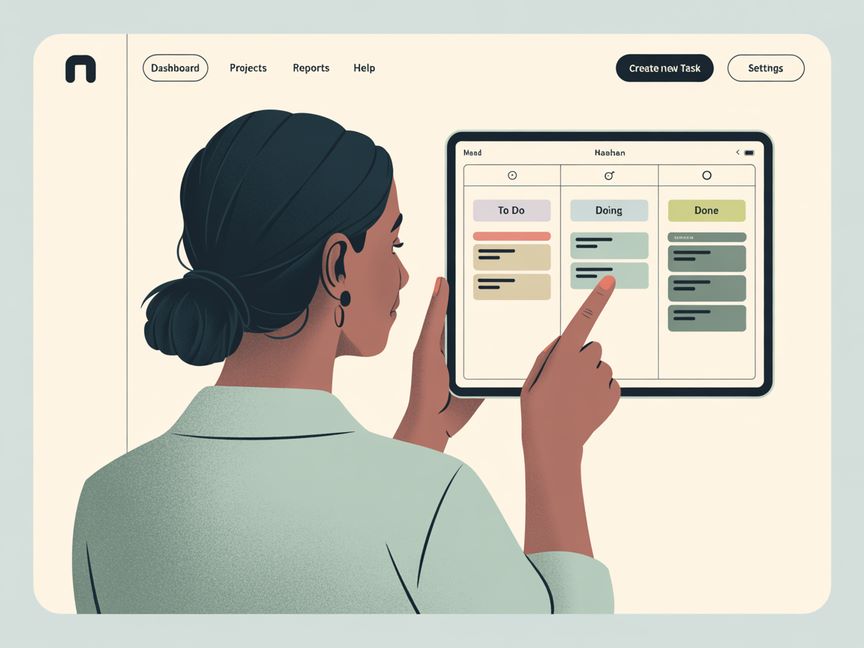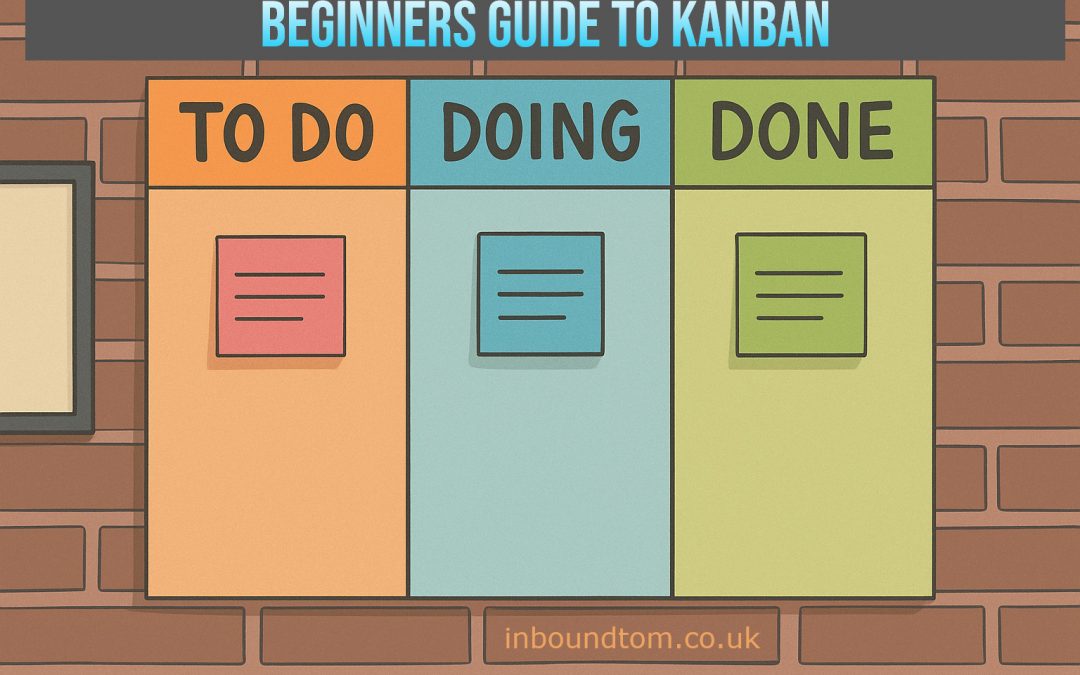Introduction to Kanban
When did you last feel overwhelmed by your to-do list? Probably today.
We chase productivity constantly. Download apps. Try new systems. Read endless guides. Yet somehow the work keeps piling up.
There is a simpler way. It comes from 1940s Japan and it still works perfectly. It is called Kanban.
This guide shows you exactly how to use it. Whether you work in video production, run a business, or just want to organise your life better.
Where Kanban came from
Kanban means signboard in Japanese. Picture a card moving across a board as work gets done.
Toyota invented it in the late 1940s. But they got the idea from supermarkets.
Here’s what Toyota noticed. Supermarkets only restock when items run low. They don’t guess what customers want. They watch what actually sells.
No overstocking. No empty shelves. Just the right amount based on real demand.
Toyota thought: could we build cars this way? Make parts only when needed. Keep inventory low. Respond to actual orders.
It worked brilliantly. The Kanban method was born.

Kanban today
The basic idea hasn’t changed. You still have a board. Tasks still move from left to right.
But now we have apps. Teams spread across the world can see the same board. Updates happen instantly.
Some people still prefer physical boards with sticky notes. Both work fine.
Kanban spread beyond manufacturing decades ago. Web designers use it. Writers use it. Parents organise household tasks with it. Project managers couldn’t live without it.
How Kanban works

Your brain processes images 60,000 times faster than text. That’s why Kanban works so well.
Picture a board with three columns:
→ To Do
→ Doing
→ Done
Each task lives on a card. Cards move across columns as work progresses.
One glance tells you everything. What needs doing. What’s in progress. What’s finished.
No hunting through emails. No checking multiple spreadsheets. Just look at the board.
Teams especially love this. Everyone sees the same picture. Everyone knows who’s doing what.
I’ve coded this simple example bellow so you can try how it all works.
Kanban Board – Personal Tasks
The four Kanban principles
Good systems have rules. Kanban has four:
Make work visible
Every task goes on the board. Nothing hidden. Nothing forgotten.
Limit work in progress
Too many active tasks means nothing gets done. Set limits for each column.
Manage flow
Watch how work moves. Find where it gets stuck. Fix those spots.
Keep improving
The board shows problems clearly. When you see them, solve them.
Getting started with Kanban
Most productivity systems need hours of setup. Categories, tags, priorities, projects.
Kanban needs two things:
→ A board with columns
→ Cards for your tasks
That’s it. You can start right now.
Setting up your board
Different work needs different boards. Here are some examples:
Personal tasks
→ To Do
→ Doing
→ Done
Sales pipeline
→ New Leads
→ First Contact
→ Proposal Sent
→ Negotiating
→ Closed
Blog writing
→ Ideas
→ Research
→ Writing
→ Editing
→ Published
Software development
→ Backlog
→ Selected
→ In Progress
→ Testing
→ Deployed
How we use Kanban for SEO
We run an SEO agency in Plymouth. Kanban helps us with almost everything.
Link acquisition
→ Prospect Research
→ Outreach Sent
→ Response Received
→ Content Placed
→ Link Live
We track 50+ link opportunities at once. The board shows exactly where each one stands. No spreadsheet needed.
Client prospecting
→ Leads
→ Initial Contact
→ Discovery Call
→ Proposal Sent
→ Contract Signed
Sales cycles take weeks. Cards show which prospects need attention today.
Content Marketing & Blog Content Creation
→ Topic Ideas
→ Keyword Research
→ Outline Complete
→ First Draft
→ Final Edit
→ Published
Writers see their pipeline. Editors know what’s coming. Nothing gets lost between stages.
The magic happens when you spot patterns. Too many cards stuck in Outreach Sent? Time to improve email templates. Bottleneck at Final Edit? Need another editor.
Kanban tools you can use
Avoid subscription tools. There’s no way to justify monthly costs for something this simple. Kanban is just cards on a board. Don’t let anyone convince you otherwise.
Analogue options
→ Whiteboard or wall with sticky notes
Classic. Immediate. Perfect for home office. Get a big whiteboard, some markers for columns, and a pack of sticky notes. You’re done.
→ Cork board with index cards
Pin them up. Move them around. Satisfying. The tactile feedback helps some people think better.
→ Wall with masking tape
Cheap. Scales to any size. Use painter’s tape to create columns on any wall. Move cards around with tape or use sticky notes.
→ Kanban in Notebook
Draw columns in a notebook. Move tasks by rewriting them. Portable personal Kanban that goes anywhere.

Digital tools worth using
(I’ve tried to focus on open source and indie tools. There is no need to pay subscription for this kind of tool.)
→ Kanbanier
→ Kanboard
Minimal and fast. No bloat. Self-hosted, open source. Runs on a £5 VPS or your old laptop. Does exactly what it should, nothing more.
→ Wekan
Open source Trello clone. Self-host on your own server. All the features without the corporate tracking.
→ Focalboard
Made by Mattermost. Works standalone or integrated. Clean interface, self-hosted, respects your privacy.
→ Planka
Looks gorgeous. Docker setup takes five minutes. Feels like a premium tool but completely free and open source.
→ TaskBoard
Dead simple PHP app. Upload to any web host. No database needed. Old school but works perfectly.
→ Nullboard
Runs entirely in your browser. No server, no account. Saves to local storage. Just open the HTML file and start.
Personal Kanban for Obsidian
obsidian.md with Kanban plugin
If you already use Obsidian for notes, this plugin turns them into Kanban boards. Markdown-based, works offline.
Vikunja
Self-hosted, actively developed. Has a web app, desktop app, mobile apps. No vendor lock-in.
KanbanFlow
Has a free tier that’s actually usable. Small team, not venture-funded. Includes a Pomodoro timer which is nice.
Trello
If you must use something hosted, Trello’s free tier still works.
Hybrid approach
Physical board for daily work. Digital backup for remote access. Best of both worlds.
Is Kanban right for you?
Do these sound familiar?
I don’t know what stage that project is at.
When will this be finished?
Who’s working on what?
What should I do next?
What did I actually accomplish this week?
If you ask these questions, you need Kanban. It answers all of them instantly.
Tips for success
Start small
Don’t add every task you’ve ever thought of. Begin with current work only.
Set WIP limits
Work In Progress limits keep you focused. Three tasks in Doing column, maximum.
Move cards daily
Keep the board current. Move finished work immediately.
Review regularly
Look for patterns. Where do cards get stuck? What takes longer than expected?
Celebrate progress
Leave completed cards visible for a while. Seeing finished work motivates.
Common mistakes to avoid
Adding too many columns. Three to five works best.
Making cards too vague. Be specific about what done looks like.
Ignoring WIP limits. They feel restrictive but boost productivity.
Not updating the board. Stale boards lose their power.
Final thoughts
Kanban transforms how you work. Not through complex rules or fancy features. Through simple visibility.
You see what needs doing. You limit what you tackle at once. You watch progress happen.
Start today. Grab some sticky notes or open Trello. Create three columns. Add a few tasks.
Then watch your productivity transform. One card at a time.
Ready to see all your work clearly? Time to try Kanban.

